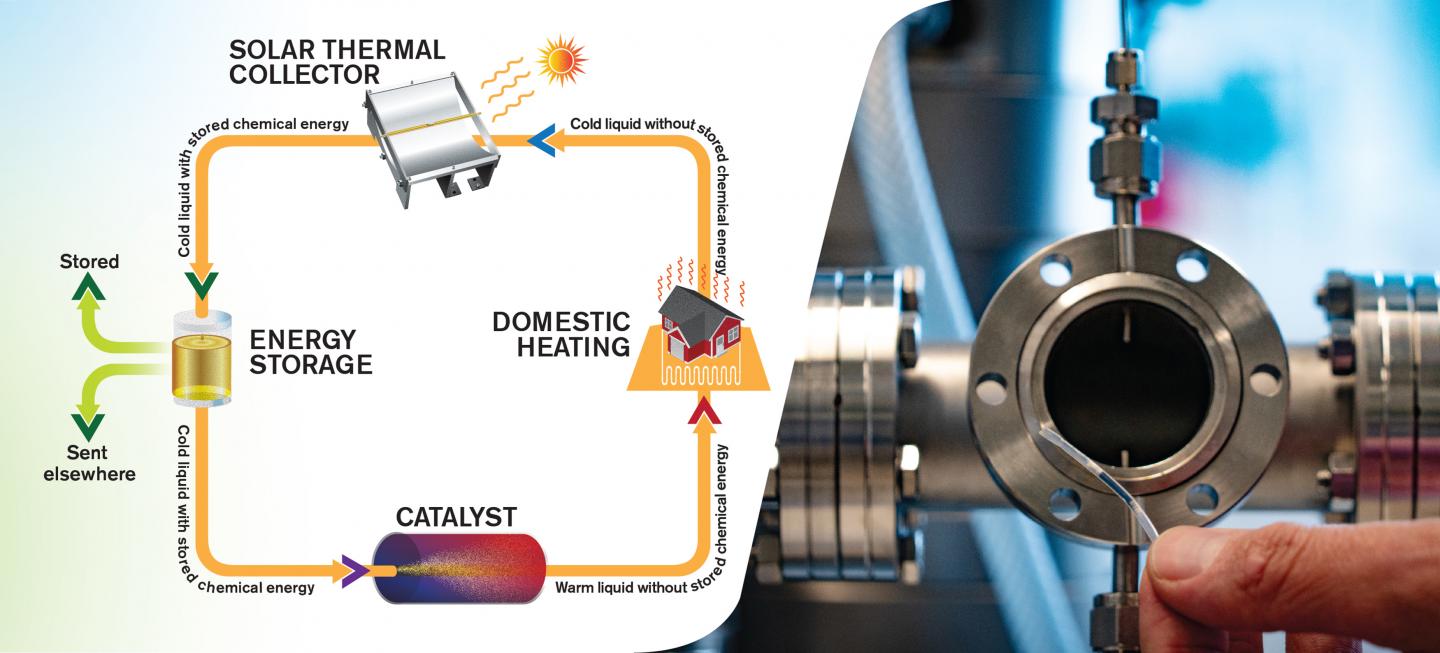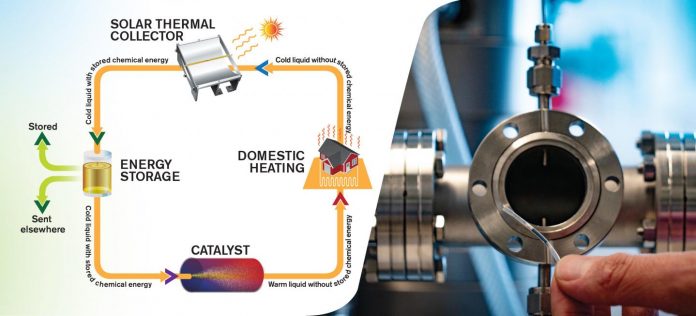
Photo: The specially designed molecule and energy system by the researchers from Chalmers has demonstrated unique abilities to catch and store solar energy. The image to the right shows a tube…
view more
Credit Image: Yen Strandqvist/Johan Bodell/Chalmers University of Technology
Over the last few years, a specially designed molecule and an energy system with unique abilities for capturing and storing solar power have been developed by a group of researchers from Chalmers University of Technology in Sweden. Now, an EU project led by Chalmers will develop prototypes of the new technology for larger scale applications, such as heating systems in residential houses. The project has been granted 4.3 million Euros from the EU.
In order to make full use of solar energy, we need to be able to store and release it on demand. In several scientific articles over the last few years, a group of researchers from Chalmers University of Technology have demonstrated how their specially designed molecule and solar energy system, named MOST (Molecular Solar Thermal Energy Storage System), can offer a solution to that challenge and become a vital tool in the conversion to fossil-free energy.
The technology has generated great interest worldwide. With the MOST system, solar energy can be captured, stored for up to 18 years, transported without any major losses, and later released as heat when and where it is needed. The results achieved in the lab by the researchers are clear, but now more experience is needed to see how MOST can be used in real applications and at a larger scale.
“The goal for this EU-project is to develop prototypes of MOST technology to verify potential for large-scale production, and to improve functionality of the system,” says Kasper Moth-Poulsen, coordinator of the project, and Professor and research leader at the Department for Chemistry and Chemical Engineering at Chalmers.
Within the project, the technology will be developed to become more efficient, less expensive and greener, thereby pushing towards products that can be used for real applications. Strong research teams from universities and institutes in Sweden, Denmark, the United Kingdom, Spain and Germany will connect and work together.
“A very exciting aspect of the project is how we are combining excellent interdisciplinary research in molecule design along with knowledge in hybrid technology for energy capture, heat-release and low-energy building design,” says Kasper Moth-Poulsen.
Advances in the development of MOST technology have so far exceeded all expectations. The first, very simple – yet successful – demonstrations took place in Chalmers’ laboratories. Among other things, the researchers used the technology in a window film to even out the temperature on sunny and hot days and create a more pleasant indoor climate. Outside the EU project, application of the molecule in blinds and windows has begun, through the spin-off company Solartes AB.
“With this funding, the development we can now do in the MOST project may lead to new solar driven and emissions-free solutions for heating in residential and industrial applications. This project is heading into a very important and exciting stage,” says Kasper Moth-Poulsen.
More about: The function of the MOST technology
The technology is based on a specially designed molecule which when hit by sunlight changes shape into an energy-rich isomer – a molecule made up of the same atoms but arranged together in a different way. The isomer can then be stored for later use when needed, such as at night or in winter. The researchers have refined the system to the point that it is now possible to store the energy for up to 18 years. A specially designed catalyst releases the saved energy as heat while returning the molecule to its original shape, so it can then be reused in the heating system.
More about: The EU project
The EU project, which is also named “Molecular Solar Thermal Energy Storage Systems”, will extend over 3.5 years and has been allocated 4.3 million Euros. Partners in the project Include: Chalmers University of Technology, University of Copenhagen, University of Rioja, Fraunhofer Institute, ZAE Bayern and Johnson Matthey. At Chalmers, researchers from the Department of Chemistry and Chemical Engineering and the Department of Architecture and Civil Engineering will participate.
###
TDnews (tunisiesoir.com)















